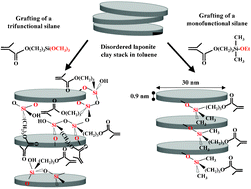Silylation of laponite clay particles with monofunctional and trifunctional vinyl alkoxysilanes†
Abstract
We report in this work the grafting of laponite clay particles with monofunctional γ-methacryloxypropyl dimethyl methoxy

* Corresponding authors
a
Laboratoire de Chimie et Procédés de Polymérisation, UMR 140 CNRS/CPE, Bât. 308, 43, Bd. du 11 Nov. 1918, BP 2077, 69616, Villeurbanne Cedex, France
E-mail:
bourgeat@lcpp.cpe.fr
b Laboratoire des Multimatériaux et Interfaces, UMR CNRS 5615, Université Claude Bernard Lyon 1, 69622 Villeurbanne Cedex, France
c Laboratoire de Génie des Procédés Catalytiques – CPE, Bât. 308F, 43, Bd. du 11 Nov. 1918, BP2077, 69616, Villeurbanne Cedex, France
We report in this work the grafting of laponite clay particles with monofunctional γ-methacryloxypropyl dimethyl methoxy

 Please wait while we load your content...
Something went wrong. Try again?
Please wait while we load your content...
Something went wrong. Try again?
N. N. Herrera, J. Letoffe, J. Reymond and E. Bourgeat-Lami, J. Mater. Chem., 2005, 15, 863 DOI: 10.1039/B415618H
To request permission to reproduce material from this article, please go to the Copyright Clearance Center request page.
If you are an author contributing to an RSC publication, you do not need to request permission provided correct acknowledgement is given.
If you are the author of this article, you do not need to request permission to reproduce figures and diagrams provided correct acknowledgement is given. If you want to reproduce the whole article in a third-party publication (excluding your thesis/dissertation for which permission is not required) please go to the Copyright Clearance Center request page.
Read more about how to correctly acknowledge RSC content.
 Fetching data from CrossRef.
Fetching data from CrossRef.
This may take some time to load.
Loading related content
